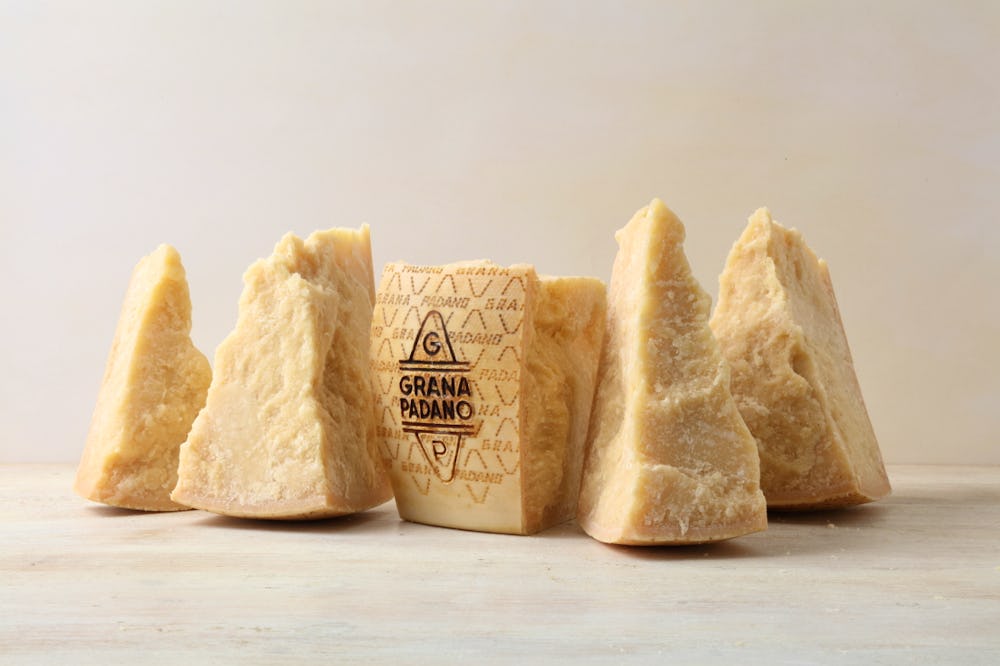Every food lover cares about the provenance of ingredients – and Grana Padano boasts more provenance than most other cheeses. This delicious hard Italian cheese has a proud heritage and can trace its history back to 1135, when it was created by Benedictine monks at Chiaravalle Abbey in the Po Valley, south of Milan.
The monks discovered an ingenious way of preserving the surplus milk they produced: by turning it into a cheese that had to be matured to reach its prime. The unique savoury taste of the cheese was an instant hit, and soon it was being produced throughout the Po Valley. The locals called it formaggio di Grana, or grainy cheese, because of its grainy texture.
Word of this tasty local cheese soon spread and it went on to become popular all over Italy, adopting the name Grana Padano, after the Italian name for the Po Valley: Pianura Padana. Fast-forward to the 1950s and that name was formally recognised within Europe, as the Italian government announced rules to protect the designations of origin of ingredients produced in a particular area.
The European Union recognised the provenance and heritage of Grana Padano in 1996, granting it Protected Designation of Origin, or PDO, status. Since then, the production of Grana Padano has been guaranteed by strict specification rules to ensure its quality.
How is Grana Padano made?

Grana Padano PDO is a semi-fat hard cheese made from partially-skimmed milk, produced by cows milked only twice daily. It takes 15 litres of milk to produce 1kg of cheese. The milk is heated in large cone-shaped copper-lined cauldrons to produce curd, which is heated, stirred, broken into grain size pieces and then left to settle at the bottom of the cauldron. The cheese-makers then divide this cheese mass into two equal parts, known as twin wheels, each of which is wrapped in a cloth.
Each wheel will be placed in a tightly fitting mould and pressed down with a heavy board. After about 12 hours, a band is inserted between the mould and the cheese, to imprint all the marks of origin on its rind, including a clover symbol, the registry number of the dairy, initials of the province and month and year of production, as well as little dotted lozenges saying Grana and Padano.
Then 24 hours later, the wheel will be placed in a steel mould, where it will acquire its final shape and be ready for salting in brine, for around 14-25 days. After this, it will be dried in a heated room, then aged for nine to over 24 months. During this ageing process, Grana Padano undergoes a series of physical, chemical and microbiological changes that contribute to its final unique taste and texture.
After nine months of ageing, each wheel of Grana Padano is checked for quality and if it passes all the tests, it will be fire-branded, as proof of its provenance and quality.
How does Grana Padano taste?

With a fine grainy structure and distinctive mellow flavour, Grana Padano is produced in three vintages:
The three vintages
Grana Padano PDO, 9-16 months – the mildest and softest type of Grana Padano. Pale yellow in colour, its taste is milky and delicate. At this age, it is perfect for gratins, ideal as an appetiser or used as shavings on vegetables, a fresh salad or beef carpaccio.
Grana Padano PDO, over 16 months – has a grainier texture and slightly stronger flavour. It is a straw-yellow colour and crumbles when cut. It has a tangy taste that makes it ideal for grating over dishes, using in pasta dishes and risottos, or simply enjoying as part of a cheese-board.
Grana Padano Riserva PDO – with over 20 months of ageing, Riserva has a dark, straw-yellow colour, grainy texture and flaky structure. With its richer, fuller taste it can be used in a number of gourmet dishes or as part of a luxury cheese-board with nuts, fruits and chutneys.
These different styles of maturation mean that Grana Padano is a hugely versatile cheese for any occasion. It can be served on its own, cut in chunks, with an aperitif or as part of a cheese-board, as well as being used to create a variety of recipes. It can also be paired with a great variety of wines, from sparkling whites such as Prosecco to full-bodied, tannic reds and even sweet dessert wines.
There's no denying the popularity of Grana Padano either. and it's easy to see why it's so loved. In 2018, nearly 5 million wheels of Grana Padano were crafted, with 125,000 of them making their way to the UK.
If you think no meal is complete without cheese, check out our pick of the best London restaurants for cheese.